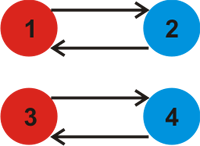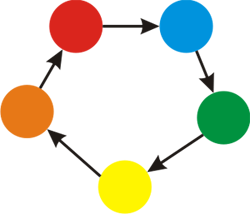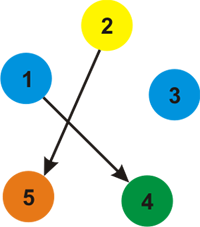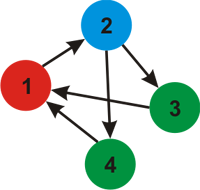CF183C.Cyclic Coloring
普及/提高-
通过率:55.61%
AC君温馨提醒
该题目为【codeforces】题库的题目,您提交的代码将被提交至codeforces进行远程评测,并由ACGO抓取测评结果后进行展示。由于远程测评的测评机由其他平台提供,我们无法保证该服务的稳定性,若提交后无反应,请等待一段时间后再进行重试。
题目描述
You are given a directed graph G with n vertices and m arcs (multiple arcs and self-loops are allowed). You have to paint each vertex of the graph into one of the k (k<=n) colors in such way that for all arcs of the graph leading from a vertex u to vertex v , vertex v is painted with the next color of the color used to paint vertex u .
The colors are numbered cyclically 1 through k . This means that for each color i (i<k) its next color is color i+1 . In addition, the next color of color k is color 1 . Note, that if k=1 , then the next color for color 1 is again color 1 .
Your task is to find and print the largest possible value of k (k<=n) such that it's possible to color G as described above with k colors. Note that you don't necessarily use all the k colors (that is, for each color i there does not necessarily exist a vertex that is colored with color i ).
输入格式
The first line contains two space-separated integers n and m ( 1<=n,m<=105 ), denoting the number of vertices and the number of arcs of the given digraph, respectively.
Then m lines follow, each line will contain two space-separated integers ai and bi ( 1<=ai,bi<=n ), which means that the i -th arc goes from vertex ai to vertex bi .
Multiple arcs and self-loops are allowed.
输出格式
Print a single integer — the maximum possible number of the colors that can be used to paint the digraph (i.e. k , as described in the problem statement). Note that the desired value of k must satisfy the inequality 1<=k<=n .
输入输出样例
输入#1
4 4 1 2 2 1 3 4 4 3
输出#1
2
输入#2
5 2 1 4 2 5
输出#2
5
输入#3
4 5 1 2 2 3 3 1 2 4 4 1
输出#3
3
输入#4
4 4 1 1 1 2 2 1 1 2
输出#4
1
说明/提示
For the first example, with k=2 , this picture depicts the two colors (arrows denote the next color of that color).
 With k=2 a possible way to paint the graph is as follows.
With k=2 a possible way to paint the graph is as follows.
 It can be proven that no larger value for k exists for this test case.
It can be proven that no larger value for k exists for this test case.
For the second example, here's the picture of the k=5 colors.
 A possible coloring of the graph is:
A possible coloring of the graph is:
 For the third example, here's the picture of the k=3 colors.
For the third example, here's the picture of the k=3 colors.
 A possible coloring of the graph is:
A possible coloring of the graph is:
